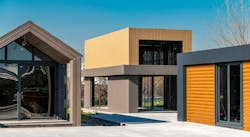What Are Our Affordable Housing Options, Really?
The United States has a housing affordability problem. You know it, I know it, and certainly people who want to buy or rent homes know it.
In Q3 2023 (the most recent data available), just 37.4% of new and existing homes sold were affordable to families earning the U.S. median income of $96,300, according to the National Association of Home Builders/Wells Fargo Housing Opportunity Index—a record low.
RELATED
- Prefab ADUs: A Rising Trend in Affordable Housing and Off-Site Construction Solutions
- Motel Conversion: A Motel Becomes a Model for Affordable Housing
- More Americans Are Moving House in Search of Affordability
Seeking True Solutions for Creating Affordable Housing
Reversing that trend is a complex issue. There is no silver bullet that will better align home prices and income. But rather than streamline stick-building—the most impactful thing in a builder’s control—some in our industry seem fixated on relatively fringe, albeit innovative, ideas to address the crisis. I’m all for solutions that offer more choices, but are they truly solutions to affordability?
Consider:
Accessory dwelling units and tiny homes. Unless you’re a single person or are with a partner who doesn’t need privacy, these options can get really small really fast. And if they aren’t built at scale (a dubious assumption given current zoning and covenants, conditions, and restrictions), their cost per square foot is comparable to building a full-size home, eroding their affordability.
3D printed homes. I’m impressed with this technology’s evolution, but is it a panacea for affordability? Like panelization and modular housing—two far more mature technologies—3D printing suffers from high capital costs and distribution issues. It’s also a new way to build and finish out a house—a disruption likely to face resistance at scale.
HUD-code homes. The average price of a double-wide is 40% of a new stick-built home and their design and construction quality is vastly improved. But shipments have stalled at 100,000 a year since 2017, a third of what they were in the late 1980s, largely due to the segment’s inability to weather and recover from economic downturns that make traditional homes more price-competitive. Can this old-school model attract new money to expand capacity and gain market share?
Single-family build-to-rent. The hype around single-family B2R has cooled recently, despite the fact that rental housing—especially within exclusive B2R communities or sections of master plans—is favored by wannabe homeowners and renters-by-choice over apartment living. But SFB2R suffers from the same production challenges as new for-sale homes (land, regulations, labor, building costs, etc.), and I question the depth of the “renters by choice” cohort once interest rates drop below 5%.
Office-to-residential conversions. Like B2R a few years ago, O2R is getting a lot of media play (and money) in today’s work-from-home economy. I’m a fan of adaptive reuse, but it’s tricky and costly to transform a corner office (much less a cubicle farm) into legit living spaces. And large, open-concept commercial buildings are often located in industrial parks with little infrastructure nearby for residents. Time (and investment returns) will tell if it’s a plausible affordable-housing solution.
About the Author

Rich Binsacca, Head of Content
Rich Binsacca is Head of Content of Pro Builder and Custom Builder media brands. He has reported and written about all aspects of the housing industry since 1987 and most recently was editor-in-chief of Pro Builder Media. [email protected]
